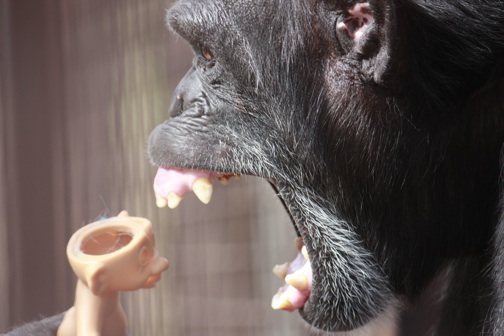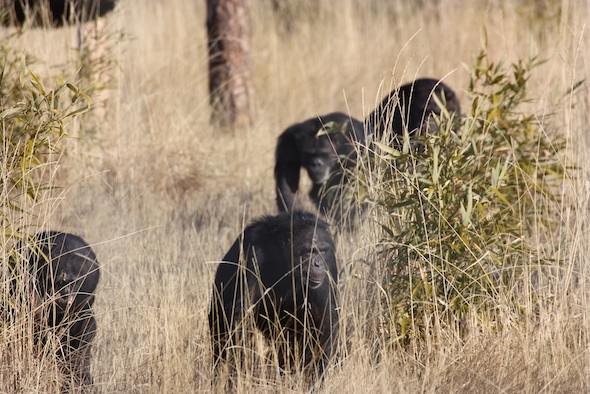Introductions. In the chimp sanctuary world, no word is as simultaneously exciting and terrifying.
Introductions occur anytime you form a social group from unfamiliar individuals. They are exciting because chimps are social creatures, and they benefit greatly from living in groups, especially groups that are large and diverse. And they are terrifying because chimpanzees can be incredibly aggressive and they don’t always welcome new members with open arms.
As many of you know, Chimpanzee Sanctuary Northwest is in the process of expanding. Our plan is to add a new wing to the facility to accommodate an additional group, but we also hope to add new members to the Cle Elum Seven family. So what can we expect when we introduce new chimps to this group that has been together for nearly a decade?
Let’s start with the good news. According to the literature, over 85% of documented introductions have been successful. In studies like these, an introduction is considered a success when a chimp is integrated into the group and remains there for at least one to two months.
Now, the bad news. Even when introductions are successful, the process can be ugly. How ugly? Let me explain it this way: the introduction protocol from a progressive and reputable zoo recommends that introductions be stopped immediately only in cases of “severe injuries that impede locomotion, loss of limb function, severe gaping wounds with bone(s) exposed, severe blood loss, [or] compromised state of consciousness.” According to the same document, a discussion about stopping the introduction may be warranted in situations of “extreme fatigue or severe loss of appetite, relentless pursuit of an individual such that the individual can’t eat, sleep, etc…[or] mental shutdown.”
Imagine if we applied these criteria to humans…
How was Billy’s first day of school?
Well, Ricky bit half of his ear off, the other kids chased him up and down the hallway all morning, and he got trapped at the top of the jungle gym for an hour during recess by a raging hoard of 6-year-olds, but by lunchtime they allowed him come down and eat a few tater tots off the floor. So, all in all, things are going pretty well!
The thing is, chimps are not humans, and we need to judge their interactions by a different standard. It’s not as cold and heartless as it may seem because if we separated them at the first sign of aggression, there would be very few chimps living in groups. The Cle Elum Seven are a good example of this. They’re all missing bits and pieces of ears, fingers, and toes from fights during their time in the lab and here at the sanctuary. But by and large, they’ve learned to get along, and they’ll do the same when it comes time to add someone new to the mix.
Despite all the fighting and potential for injury, chimps will usually work things out if we allow them to. And when they do, they get to take back a little piece of the life they should have known in the wild.







This was great, J. B. Love your final point, if only to emphasise the idea that if it goes south, that may be a relative term only to humans and they’ll have their own way of working it out in the end. Kind of scary to think about for those of us who don’t work where you do, but I’m sure you see it all the time.
This may be a premature question, but do you know already from where the chimps will come, and if there might be babies in the mix? Gotta luv da babies.
🙂
Hi Carla – No, we don’t know who it will be at this point. But thankfully, there aren’t many baby chimps in the U.S. due to an NIH breeding moratorium that has been in place since 1995. There are a handful in the entertainment industry and a small number of young chimps (not babies) at one lab that seemingly chose to ignore the moratorium. So, in all likelihood, any chimps in need of placement will be juveniles or adults.
What hard jobs you have! That sounds like it could be very frightening and intense. As humans I know we have almost a need to anthropomorphize them.
Based on the depth of knowledge, insights and empathy you each have for chimps in general and these amazing 7 specifically, I can’t imagine who better qualified. It will be all that you described in one fashion or another and then some but you will help them feel safe to trust you will not move forward with each step, too quickly. Moving as they let you know they are ready. Thank you for all that you do and for sharing your daily posts of your lives together!
I confess, when I think of introducing new chimps to the Cel Elum Seven family, I worry. But I also see that Save The Chimps and Chimp Haven do it, and with time and proper introductions new friendships, bonds, and families are formed. Chimpanzees that are still languishing in labs, confined as pets, and suffering in entertainment need to be released to sanctuaries and I personally can’t think of a better place for them than CSNW. Your last statement says it all.
Hi Kathleen – Yes, Save the Chimps and Chimp Haven have done hundreds, if not thousands, of introductions over the last 15 years, and zoos and labs have been doing them on a regular basis for decades before that. And even the small sanctuaries do introductions once and a while.
For us, bringing new chimps into the Cle Elum Seven family will be just as beneficial to the Seven as it will be to the chimps being rescued. Our chimps are getting older and despite the fact that they will always be “the Seven”, there won’t always be seven of them here. So what could be better than to keep this group going with new family members and new friendships.
I so appreciate the honesty of the posts from the chimp sanctuary, which help me to learn much about these fascinating and beautiful, complex beings.
It undoubtedly takes some courage at times to run a chimp sanctuary — and it’s clear that it is enormously rewarding as well.
Yikes! That was difficult to read. I appreciate your knowledge and attitude! Exactly how DO you separate individuals who are in danger?
Every facility has a slightly different way of doing introductions, based on different philosophies but also based on practical things like facility design. A lot of places do introductions in area where the chimps could be physically separated into different rooms if the opportunity arises – for example, if a serious fight takes place and one chimp retreats through a doorway, the caregivers are ready to slam the door shut. Caregivers are often prepared to distract the fighting chimps with a spray from a hose or a blast into the air from a CO2 fire extinguisher (just for the noise). But there is always the risk that you won’t be able to separate them, which is why caregivers must study the chimps’ interactions with each other before allowing them to have full contact. For example, if the chimps meet each other through the mesh, do they try to groom each other? Do they show affinitive behavior? Or do they display and fight? Some facilities even allow contact in stages, using a special doorway called a “howdy”. This door opens in small increments, which lets the chimps have progressive amounts of contact so that at each stage, the potential for injury is minimized. But whatever you do, at some point you have to hold your breath and let the chimps do their thing. And of course you should always have your veterinarian on standby in case anyone needs medical attention.
Thank you for taking the time to answer in depth!
Scary yes, but I am delighted at the prospect of your being able to save more precious chimps! I will hope they all get along and work it out without too much loss of hair/skin/blood/sleep!
The thought of CSNW expanding is so exciting! Maybe Burrito can get some testosterone in the Sanctuary!
I will be honored to help you be able to offer sanctuary for more chimps.